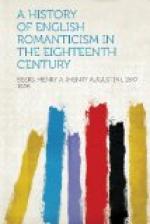On August 7 he writes to Mason that the Erse fragments have been published five weeks ago in Scotland, though he had not received his copy till the last week. “I continue to think them genuine, though my reasons for believing the contrary are rather stronger than ever.” David Hume, who afterward became skeptical as to their authenticity, wrote to Gray, assuring him that these poems were in everybody’s mouth in the Highlands, and had been handed down from father to son, from an age beyond all memory and tradition. Gray’s final conclusion is very much the same with that of the general public, to which the Ossianic question is even yet a puzzle. “I remain still in doubt about the authenticity of these poems, tho’ inclining rather to believe them genuine in spite of the world. Whether they are the inventions of antiquity, or of a modern Scotchman, either case is to me alike unaccountable. Je m’y perds.”
We are more concerned here with the impression which MacPherson’s books, taking them just as they stand, made upon their contemporary Europe, than with the history of the controversy to which they gave rise, and which is still unsettled after more than a century and a quarter of discussion. Nevertheless, as this controversy began immediately upon their publication, and had reference not only to the authenticity of the Ossianic poems, but also to their literary value; it cannot be altogether ignored in this account. The principal facts upon which it turned may be given in a nut-shell. In 1759 Mr. John Home, author of the tragedy of “Douglas,” who had become interested in the subject of Gaelic poetry, met in Dumfriesshire a young Scotchman, named James MacPherson, who was traveling as private tutor to Mr. Graham of Balgowan. MacPherson had in his possession a number of manuscripts which, he said, were transcripts of Gaelic poems taken down from the recital of old people in the Highlands. He translated two of these for Home, who was so much struck with them that he sent or showed copies to Dr. Hugh Blair, Professor of Rhetoric in the University of Edinburgh. At the solicitation of Dr. Blair and Mr. Home, MacPherson was prevailed upon to make further translations from the materials in his hands; and these, to the number of sixteen, were published in the “Fragments” already mentioned, with a preface of eight pages by Blair. They attracted so much attention in Edinburgh that a subscription was started, to send the compiler through the Highlands in search of more Gaelic poetry.
The result of the researches was “Fingal, an Ancient Epic Poem in Six Books: Together with several other poems, composed by Ossian the son of Fingal. Translated from the Gaelic language by James MacPherson,” London, 1762; together with “Temora, an Ancient Epic Poem in Eight Books,” etc., etc., London, 1763. MacPherson asserted that he had made his versions from Gaelic poems ascribed to Ossian or Oisin, the son of Fingal




